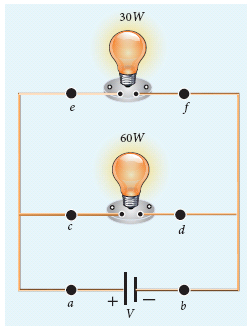St. Britto Hr. Sec. School - Madurai
12th Physics Monthly Test - 2 (Current Electricity )-Aug 2020
-
-
-
-
-
-
What is the disadvantage of electric fuse?
-
Define the term electric power and circuit its SI unit.
-
Define electric energy state its commercial units.
-
Write down the various forms of expression for power in electrical circuit.
-
Two 120 V light bulbs, one 25W and other of 100 W were connected in series across a 220 V line. One bulb burnt out instantaneously. which one wasburnt and Why?
-
What is Seebeck effect?
-
Mention are limitation of carbon resistors.
-
Two wires A & B are of the same metal of of same length have area of cross section in the
ratio of 2 : If the same potential difference is applied across each wire. What will be the retro of the circuit flowing in A & B? -
Draw I - V graph for a conductor. What does the slope represent?
-
What happens to the drift velocity of electron and to the resistance if length of conductor and to the resistance if length of conductor unchanged?
-
Of which material is a potential wire normally made and why
-
Why the resistance of the conductor increases with rise in temperature.
-
What is the use of electric furnace?
-
What is electric fuse?
-
State microscopic form of Ohm's law.
-
-
What is (i) thermoelectric current
(Ii) thermocouple. -
What is Thomson effect?
-
-
Plot a graph showing the variation of circuit I various resistance R connected to a cell of emf E and internal resistance r.
-
State Joule’s law of heating.
-
Distinguish between drift velocity and mobility.
-
When resistors are connected in series. the effective resistance is increased. Why?
-
-
A battery of voltage V is connected to 30 W bulb and 60 W bulb as shown in the figure. (a) Identify brightest bulb (b) which bulb has greater resistance?
(c) Suppose the two bulbs are connected in series, which bulb will glow brighter?

-
A potentiometer wire has a length of 4 m and resistance of 20 Ω. It is connected in series with resistance of 2980 Ω and a cell of emf 4 V. Calculate the potential along the wire.
-
-
Explain the variation of resistivity of conductor and semiconductor with change in temperature
-
In a wheat stone bridge circuit P = 7, Q = 8 , R = 12 & s = 7. Find the additional resistance to be used in series with S, so that the bridge is balanced.
-
A cell supplies a current of 0.9 A through a 2 Ω resistor and a current of 0.3 A through a 7 Ω resistor. Calculate the internal resistance of the cell.
-
A battery has an emf of 12 V and connected to a resistor of 3 Ω. The current in the circuit is 3.93 A. Calculate (a) terminal voltage and the internal resistance of the battery (b) power delivered by the battery and power delivered to the resistor
-
What is potentiometer? Give its constant and principle.
-
Four light bulbs P, Q, R, S are connected in a circuit of unknown arrangement. When each bulb is removed one at a time and replaced, the following behavior is observed.
P Q R S P removed * on on on Q removed on * on off R removed off off * off S removed on off on * Draw the circuit diagram for these bulbs.5
-
The resistance of a nichrome wire at 0 0C is 10 Ω. If its temperature coefficient of resistance is 0.004/0C, find its resistance at boiling point of water. Comment on the result.
-
Two electric bulbs marked 20 W – 220 V and 100 W – 220 V are connected in series to 440 V supply. Which bulb will be fused?
-
Explain what is (i) Thomson effect, (ii) Positive Thomson effect, (iii) Negative effect.
